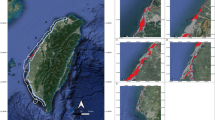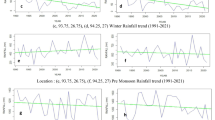Abstract
The present work targets a serious information gap created by extant fragmental and intermittent data on river bank erosion and accretion dynamics. Hence, a sequential three-decade profiling of erosion and accretion activities within the Kaziranga National Park—a protected area in the flood plain of the Brahmaputra, was undertaken. Thirty consecutive Landsat images from 1987 to 2016 were analyzed in GIS environment, to evaluate long-term sequential data and derive a baseline reference. Overlay analysis was carried out to estimate the magnitudes and intensities of erosion and accretion in spatiotemporal scale. The resultant mean rates of erosion and accretion have been estimated to be 184.2 ha/year and 93.9 ha/year, respectively. Consequently, the resultant net reduction in the park land area was 2617.7 ha, which projected a mean net rate of 90.3 ha/year. Erosion was therefore annually recurrent and dominant over accretion. The resultant area dynamics, from the assessment of the spatiotemporal scale, provided a reliable, continuous data resource that overcomes the information lacunae from available fragmented studies. In addition, assessment with sequential data displayed a more accurate reflection of actual topography as compared to intermittent data results, which in turn can validate and enrich data resources, on the area dynamics of the Brahmaputra floodplain. Finally, defining a reference perspective derived from long-term sequential data that endorses the twin episodes of erosion and accretion will be vital for floodplain management.






Similar content being viewed by others
References
Ashraf, M., Bhatti, M. T., & Shakir, A. S. (2016). River bank erosion and channel evolution in sand-bed braided reach of River Chenab: Role of floods during different flow regimes. Arabian Journal of Geosciences, 9(2), 140. https://doi.org/10.1007/s12517-015-2114-y.
Beschta, R. L., & Ripple, W. J. (2008). Wolves, trophic cascades, and rivers in the Olympic National Park, USA. Ecohydrology, 1, 118–130.
Biron, P. M., Buffin-Bélanger, T., Larocque, M., Choné, G., Cloutier, C. A., Ouellet, M. A., et al. (2014). Freedom space for rivers: A sustainable management approach to enhance river resilience. Environmental Management, 54(5), 1056–1073.
Buffin-Bélanger, T., Biron, P. M., Larocque, M., Demers, S., Olsen, T., Choné, G., et al. (2015). Freedom space for rivers: An economically viable river management concept in a changing climate. Geomorphology, 251, 137–148.
Couper, P. R., & Maddock, I. P. (2001). Subaerial river bank erosion processes and their interaction with other bank erosion mechanisms on the River Arrow, Warwickshire, UK. Earth Surface Processes and Landforms, 26(6), 631–646.
Das, A. K., Sah, R. K., & Hazarika, N. (2012). Bankline change and the facets of riverine hazards in the floodplain of Subansiri-Ranganadi Doab, Brahmaputra Valley, India. Natural Hazards, 64(2), 1015–1028.
Das, J. D., Dutta, T., & Saraf, A. K. (2007). Remote sensing and GIS application in change detection of the Barak river channel, NE India. Journal of the Indian Society of Remote Sensing, 35(4), 301–312.
Goswami, U., Sarma, J. N., & Patgiri, A. D. (1999). River channel changes of the Subansiri in Assam, India. Geomorphology, 30, 227–244.
Goyari, P. (2005). Sustainability damages and in Assam of agriculture. Economic and Political Weekly, 40(26), 2723–2729.
Haque, C. E. (1988). Human adjustments to river bank erosion hazard in the Jamuna floodplain, Bangladesh. Human Ecology, 16(4), 421–437.
Hughes, F. M. R. (1997). Floodplain biogeomorphology. Progress in Physical Geography, 21(4), 501–529.
Hutton, D., & Haque, C. E. (2003). Patterns of coping and adaptation among erosion-induced displacees in Bangladesh: Implications for hazard analysis and mitigation. Natural Hazards, 29(3), 405–421.
Kotoky, P., Bezbaruah, D., Baruah, J., & Sarma, J. N. (2005). Nature of bank erosion along the Brahmaputra river channel, Assam, India. Current Science, 88(4), 634–640.
Kotoky, P., Bezbaruah, D., & Sarma, J. N. (2015). Spatio-temporal variations of erosion-deposition in the Brahmaputra River, Majuli—Kaziranga sector, Assam: Implications on flood management and flow mitigation. In M. Ramkumar, K. Kumaraswamy, & R. Mohanraj (Eds.), Environmental management of river basin ecosystems (pp. 227–251). Cham: Springer.
Kummu, M., Lu, X. X., Rasphone, A., Sarkkula, J., & Koponen, J. (2008). Riverbank changes along the Mekong River: Remote sensing detection in the Vientiane-Nong Khai area. Quaternary International, 186(1), 100–112.
Madej, M. A., Weaver, W. E., & Hagans, D. K. (1994). Analysis of bank erosion on the Merced river, Yosemite valley, Yosemite National Park, California, USA. Environmental Management, 18(2), 235–250.
Mishra, A., & Liu, S. C. (2014). Changes in precipitation pattern and risk of drought over India in the context of global warming. Journal of Geophysical Research: Atmospheres, 119(13), 7833–7841.
Neog, R. (2018). A GIS-based study on channel variation, erosion and deposition along the bank of Dibru Saikhowa National Park (1967–2016), Assam, India. Sustainable Water Resources Management, 4(3), 499–507.
Parida, B. R., & Oinam, B. (2015). Unprecedented drought in North East India compared to Western India. Current Science, 109(11), 2121–2126.
Sarma, J. N., & Acharjee, S. (2012). A GIS based study on bank erosion by the river Brahmaputra around Kaziranga National Park, Assam, India. Earth System Dynamics Discussions, 3(2), 1085–1106.
Sarma, J. N., Borah, D., & Goswami, U. (2007). Change of river channel and bank erosion of the Burhi Dihing river (Assam), assessed using remote sensing data and GIS. Journal of the Indian Society of Remote Sensing, 35(1), 93–100.
Summerfield, M. A. (1991). Global geomorphology: An introduction to the study of landforms. New York: Longman Scientific & Technical.
Thakur, P. K., Laha, C., & Aggarwal, S. P. (2012). River bank erosion hazard study of river Ganga, upstream of Farakka barrage using remote sensing and GIS. Natural Hazards, 61(3), 967–987.
Tockner, K., & Stanford, J. A. (2002). Riverine flood plains: Present state and future trends. Environmental Conservation, 29(3), 308–330.
Ward, J. V., Tockner, K., & Schiemer, F. (1999). Biodiversity of floodplain river ecosystems: Ecotones and connectivity. Regulated Rivers: Research & Management, 15(1), 125–139.
Yang, C., Huang, Q., Li, Z., Liu, K., & Hu, F. (2017). Big Data and cloud computing: Innovation opportunities and challenges. International Journal of Digital Earth, 10(1), 13–53.
Acknowledgements
The first author is a recipient of University Grants Commission (UGC) fellowship for which UGC is acknowledged. United States Geological Survey (USGS), National Remote Sensing Centre (NRSC) and Survey of India (SOI) are acknowledged for their data. The authors are also thankful to the UGC and Department of Science and Technology (DST) for supporting the Department through UGC-SAP (Special Assistance Programme) and DST-FIST (Fund for Improvement of Science and Technology) schemes. The authors would also like to thank Dr. G. Maitra, Department of Biotechnology (DBT) Nodal cell, Tezpur University, for checking the manuscript. The authors are grateful to Dr. Amit Prakash and Dr. Reetamoni Narzary, from Tezpur University, for their help in statistical analysis and language editing respectively.
Author information
Authors and Affiliations
Corresponding author
Additional information
Publisher's Note
Springer Nature remains neutral with regard to jurisdictional claims in published maps and institutional affiliations.
About this article
Cite this article
Basumatary, H., Sah, R.K. & Das, A.K. Analyzing Area Dynamics on a Protected Floodplain Using Long-Term Sequential Data: The Case of Kaziranga National Park. J Indian Soc Remote Sens 47, 1557–1566 (2019). https://doi.org/10.1007/s12524-019-01000-x
Received:
Accepted:
Published:
Issue Date:
DOI: https://doi.org/10.1007/s12524-019-01000-x




